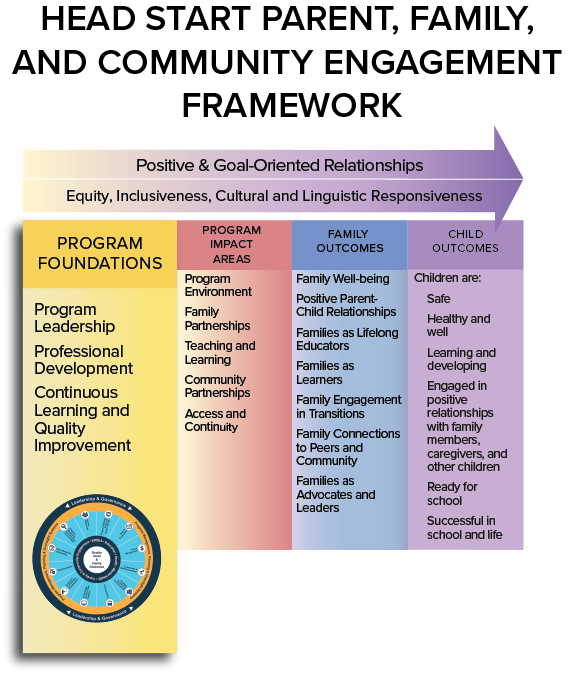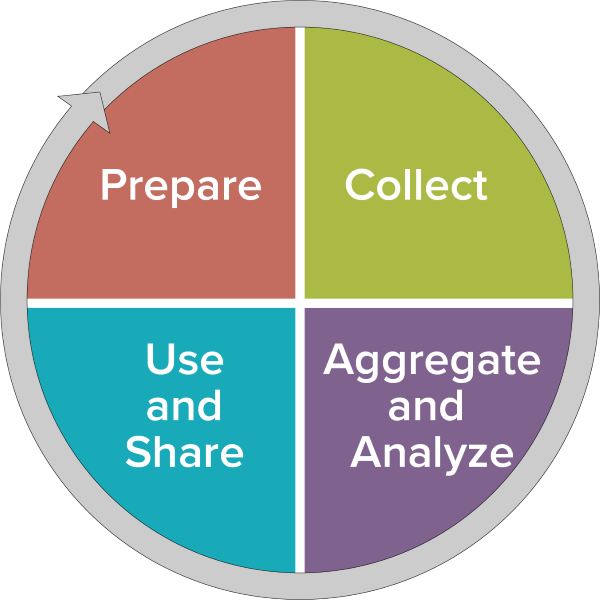The Head Start Parent, Family, and Community Engagement (PFCE) Framework and the Head Start Management Systems Wheel both emphasize leadership as central to effective family engagement and high-quality programs.
The PFCE Framework's Program Foundations column highlights two Head Start management systems for optimal family engagement: professional development and continuous learning and quality improvement. The Management Systems Wheel represents all 12 program management, planning, and oversight systems critical to high-quality service delivery.
Leadership and governance, the bedrock of effective management, is an essential element undergirding all 12 systems. These management systems are crucial to effectively operating the five services represented in the inner circle, resulting in quality child and family outcomes. As you work to support positive, goal-oriented relationships and comprehensive services, this wheel gives you a diagram for reflecting on everything you do each year, month, or day — and where your roles and responsibilities fall within the wheel.


Professional Development and Continuous Learning and Improvement
Professional development is a critical element of the PFCE Framework's Program Foundations. Carefully planned professional development is important for all staff, regardless of their role, because of its importance in parent and family engagement.
As a family services manager, you play a key role in supporting the professional development of the family services staff on your team and yourself. You foster a culture of learning when you encourage staff learning and when you participate in professional development opportunities yourself. Your role includes ensuring that your staff create individual professional development plans as required in the Head Start Program Performance Standards (HSPPS).
 When staff members come together as a community of learners, they create a mutually supportive environment for continuous learning and improvement. You can align individual and program professional development plans with continuous learning and improvement data, staff needs, and family and community feedback. These plans can include training, ongoing support (e.g., coaching and supervising), and career options information. In addition, families, other community members, and staff can co-design and co-lead training opportunities to support professional development plans.
When staff members come together as a community of learners, they create a mutually supportive environment for continuous learning and improvement. You can align individual and program professional development plans with continuous learning and improvement data, staff needs, and family and community feedback. These plans can include training, ongoing support (e.g., coaching and supervising), and career options information. In addition, families, other community members, and staff can co-design and co-lead training opportunities to support professional development plans.
The Relationship-Based Competencies (RBCs) are an invaluable tool for family services managers to use with staff as they develop the knowledge, skills, and practices they need to engage parents and families in Head Start and Early Head Start programs. You can use the RBCs in reflective supervision with your team members to identify and support them with specific competencies. Also, consider using the RBCs to:
- Design professional development opportunities for your staff.
- Create a professional development plan for yourself.
- Inform any program-wide professional development plans, policies, and structures.
Putting It into Practice Activity: Scenario and Worksheet
Read the scenario, then complete the Head Start Management Wheel: What Is Your Role? Worksheet.
Scenario: Gloria and Program Systems
Throughout Gloria's onboarding process, she builds relationships with the rest of the managers and staff. Each manager at Family Dreams orients Gloria to their role and how her role as a family services manager supports the program's coordinated approach to comprehensive services for families and children.
Gloria reviews the Management Systems Wheel to learn about the 12 management systems and Program Foundations column of the PFCE Framework to understand how she and her fellow managers contribute to effective program systems. Then, she uses the Head Start Management Wheel: What is Your Role? Worksheet to reflect on her role across management systems.
Now it's your turn to reflect on your role.
Data: Continuous Learning and Quality Improvement
Data can inform and strengthen your work related to the elements and outcomes of the PFCE Framework. Using data consistently and effectively is crucial to continuous learning and quality improvement for family services. Leaders and managers build support and capacity to use data among staff, families, and community partners.
The Four Data Activities can guide Head Start and Early Head Start program leadership, staff, and families in using data to improve family and community engagement practices and outcomes.
These activities are:
- Prepare. What program goals is your program working on? What do you want to improve?
- Collect. What items do you currently collect to support your identified program goals? What should you start to collect or stop collecting?
- Aggregate and Analyze. Who reviews the data (e.g., managers, teachers, family services staff, Policy Council, parents, family members)?
- Use and Share. How do you use the data? Who do you share it with?
Explore Measuring What Matters: Using Data to Support Family Progress and the Data in Head Start and Early Head Start Series to guide you in these four data activities.
You'll want to use the data you collect to identify your program's strengths and needs. When used effectively, data helps you to shape:
- In-planning tasks: Roles and responsibilities that your program needs to assign and put in place
- In-progress tasks: Roles and responsibilities that your program has newly implemented
- In-place tasks: Roles and responsibilities that your program put in place and is implementing
Putting It into Practice Activity: Scenario and Worksheet
Read the scenario, then complete the What Data Are You Collecting? Worksheet.
Scenario: Gloria Focuses on Family Data
In a meeting that Gloria attends with program management, Molly, the program director, discusses the five-year program plan, program goals, and HSPPS, specifically around Family engagement, 45 CFR §1302.50. Next, the education manager, Anthony, discusses the program's data-driven culture and explains that classroom child data and family partnership data are regularly collected, analyzed, and used to inform their systems, professional development, and services with children and families. Finally, the health manager, Maria, explains how management and staff teams use the HSPPS and the Head Start Monitoring Protocols to implement Office of Head Start guidance.
Gloria uses the What Data Are You Collecting? Worksheet to explore what data the program is collecting or should collect to support family outcomes.
Now it's your turn to reflect on the data your program can collect and use to inform family services.
You Got This!
"The secret of getting ahead is getting started. The secret of getting started is breaking your complex overwhelming tasks into small manageable tasks, and then starting on the first one."
-Mark Twain
Read more:
Resource Type: Article
National Centers: Parent, Family and Community Engagement
Audience: Family Service Workers
Last Updated: November 3, 2023